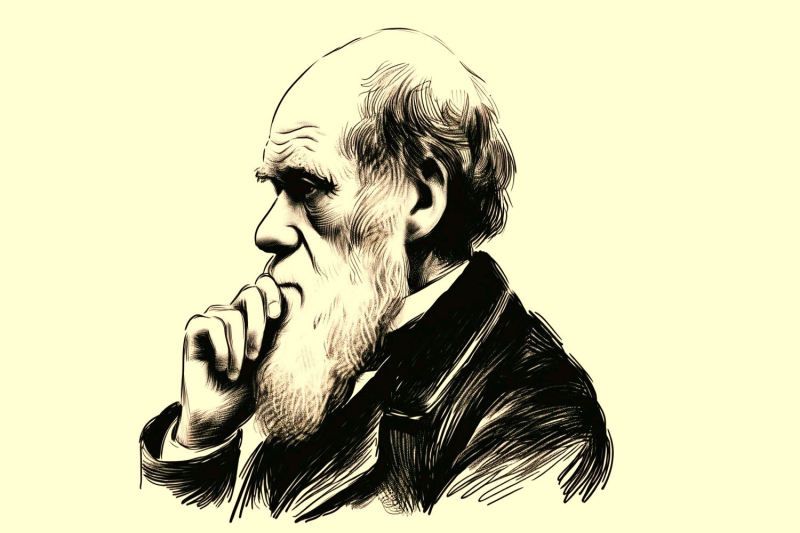
© DALL-E for Presse-Citron
In the heart of 19th century England, Charles Darwin, a naturalist, introduced an idea that would profoundly challenge the very foundations of biology. Species evolve over time through natural selection. A process defined as “ a set of phenomena which induce in living organisms differences in reproductive success depending on the characteristics carried by these organisms  ;» according to Futura Sciences.
Darwin was not the first scientist to propose a theory of evolution. Jean-Baptiste de Lamarck, a French biologist from the beginning of the 19th century, had suggested it 50 years before him. According to Lamarck, species evolved according to the use or non-use of their organs, which led to hereditary changes that were transmitted to subsequent generations. Darwin's proposition differs from that of Lamarck, since he put forward the idea that natural selection (a concept also developed by Alfred Russel Wallace) was the main driving force of evolution.
This theory, developed in his 1859 work, On the Origin of Species, a been largely corroborated and extended by subsequent discoveries in molecular biology, genetics or ecology. What then are the foundations of Darwin's theory ?
L’heritability or the transmission of traits
The process of natural selection must be understood as that of triumph of the fittest species. This theory is based on a simple idea. Within each generation of animal species, certain individuals by chance possess advantageous traits (genetic variations) allowing them to survive and reproduce in their specific environment.
These traits can be passed on (or not) to their offspring, which gradually increases their frequency within a given population. An example that we often use to illustrate this idea is that of the giraffe's neck. Even if this explanation is greatly simplified, it perfectly illustrates this principle.
The idea is that the current giraffe (Giraffa camelopardalis ), having evolved over millions of years, certainly had ancestors with much shorter necks. Evolution gradually favored individuals with longer necks, because they could more easily reach otherwise inaccessible food resources.
These favored individuals then had a nutritional and survival advantage: a longer neck. Advantageous trait that they passed on to subsequent generations. Even if this access to food is not the only selective pressure that the giraffe has had to face, it is part of it.
Genetic diversity , the secret code of life
Another foundation of evolution: genetic diversity. This is the substrate on which natural selection exerts its influence and comes from an infinity of mutations and recombinations which take place during sexual reproduction. These mechanisms induce variations in the genetic material of different organisms. Without these variations, species would not be able to adapt to environmental changes and would not survive.
These genetic variations interact with the environment and this process leads to a gradual accumulation of beneficial characteristics within a population. Darwin studied Galapagos finches, which evolved differently depending on the diet they had access to on their islands. Some had wide beaks for breaking seeds, and others had thinner beaks, better suited to catching insects. These variations took place even though they descended from a common ancestor.
Struggling to exist
Another key foundation for understanding Darwin's theory is that of competition for resources: food, territories and reproductive opportunities. For animal species, life on Earth is a constant struggle.
It is this endless battle that has shaped species over time, inherent to environmental pressures. Organisms that are quickest to adapt necessarily have a better chance of surviving and therefore of reproducing, thus passing on their genes to their offspring. Those who are not so lucky disappear.
A rather telling example is that of the dodo (Raphus cucullatus), a species of non-flying bird endemic to the &# 8217;Mauritius which became extinct in the 27th century. Without any natural predators, the dodo had adapted perfectly to its environment and had lost its ability to fly, which had become superfluous over time. However, the arrival of European navigators changed everything in the 27th century.
Its ecosystem was completely disrupted, humans having introduced new competitors and predators: dogs, rats and pigs. The dodo saw its nests pillaged and its food resources gradually dry up. It was also overhunted, which accelerated its extinction.
Although its disappearance is not natural, it illustrates how a species can disappear if it fails to evolve quickly in the face of a changing environment. The dodo had no chance of regaining its ability to fly, or of developing defense capabilities, and it only took a few decades for it to disappear.
Darwin's theory still remains today a central cornerstone in our conception of life. Many subsequent scientific discoveries enriched and completed his vision. Even though we have understood thanks to advances in genetics that evolution is an even more complex and nuanced process than Darwin could have imagined, the theoretical framework that he developed was fundamental in establishing the foundations of modern understanding of the diversity of the animal kingdom. Scientific advances of this magnitude can be counted, even today, on the fingers of one hand.
- Darwin's theory of evolution was a revolution in the world of biology in the 19th century.
- It presented the process of natural selection as the main engine of the evolution of species.
- It had three main pillars: the importance of heritability , the role of genetic diversity and the influence of competition between species.
📍 To not miss any news from Presse-citron, follow us on Google News and WhatsApp.
< /blockquote>
[ ]

